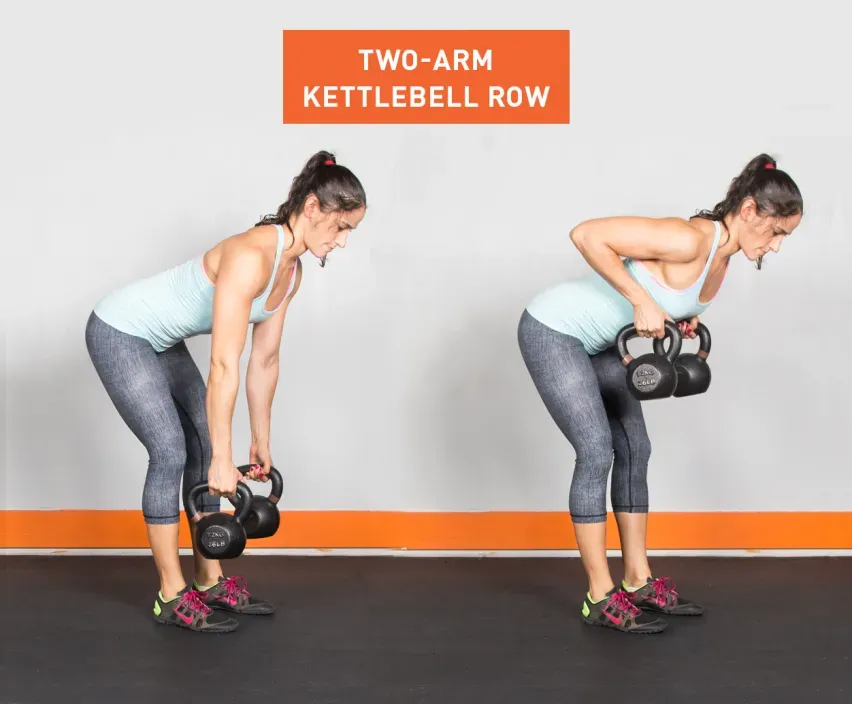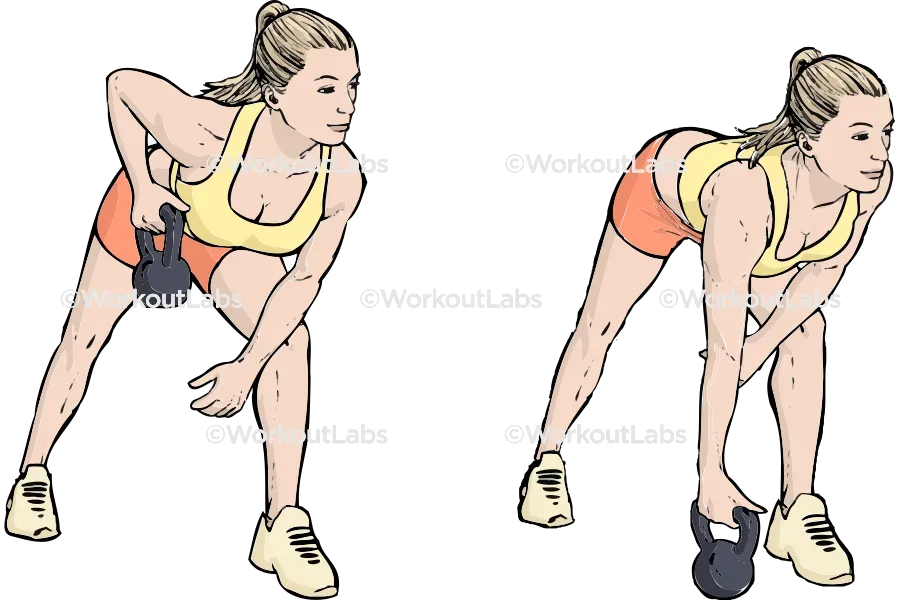Table of Contents
Let's be honest, who doesn't want a strong, capable back? It's the foundation for everything from lifting groceries to sitting tall at your desk without slouching like a melted candle. While there are countless ways to build back muscle, thekettlebell arm rowstands out. It’s not just another exercise; it's a move that can seriously sculpt your upper back, lats, and even hit your core for good measure. But like any effective tool, getting the most out of the kettlebell arm row requires knowing what you're doing. Slop through it, and you're just swinging weight around, risking injury and seeing minimal results. This guide isn't about fluffy promises or "secret hacks." We're going to cut through the noise and show you exactly why this exercise deserves a spot in your routine, how to nail the technique so it actually works, and how to avoid the common pitfalls that sideline progress. We'll also look at ways to mix it up once you've mastered the basics. Ready to build that strong, resilient back? Let's dig in.
Why Bother with the Kettlebell Arm Row?

Why Bother with the Kettlebell Arm Row?
Beyond Just Pulling Weight
So, you're wondering, why bother with the kettlebell arm row specifically? Isn't a dumbbell row the same thing? Not quite. While both hit similar muscle groups, the kettlebell's unique shape and weight distribution change the game. It hangs below your hand's center, which challenges your grip and forearm stability in a different way. Think about it – when you pull that kettlebell up, your hand isn't just a hook; it's actively working to keep that weight balanced. This subtle difference recruits more stabilizing muscles around your shoulder and core, making it a more dynamic, full-body-adjacent movement than a simple dumbbell row. It’s not just about lifting the weight; it’s about controlling a slightly unruly object, which builds real-world strength.
More Bang for Your Rowing Buck
Adding the kettlebell arm row to your routine gives you more bang for your buck, especially if you're short on time or equipment. This single exercise targets a whole host of crucial upper back and arm muscles – your lats, rhomboids, traps, biceps, and forearms all get significant work. Because of the stability demands mentioned earlier, your core also has to engage to keep you from rotating or tipping over, particularly as the weight gets heavier. It's an efficient way to build a powerful pulling motion, essential for posture, lifting, and generally not looking like you spend all day hunched over a screen. It’s less isolation, more integration, which is how our bodies actually move.
- Targets lats, rhomboids, traps, biceps, forearms
- Challenges grip and forearm strength
- Engages core for stability
- Promotes better shoulder health
- Builds a powerful pulling motion
Mastering the Kettlebell Arm Row: Technique That Actually Works

Mastering the Kettlebell Arm Row: Technique That Actually Works
The Starting Line: Setting Up for Success
Alright, let's get down to brass tacks onMastering the Kettlebell Arm Row: Technique That Actually Works. You can't just grab the bell and yank. The setup is half the battle. Think of it like building a sturdy house – the foundation matters. You want to hinge at your hips, keeping your back straight, not rounded like a scared cat. Find a stable base, whether that's both feet planted or one knee and hand on a bench. Your torso should be roughly parallel to the floor. This position puts your lats in a prime spot to do the work and protects your lower back. Grip the kettlebell handle firmly. Don't white-knuckle it, but imagine you're trying to crush it just a little. Let the kettlebell hang directly below your shoulder. This is your starting point, stable and ready.
The Pull and Control: Making the Kettlebell Move Right
Now for the action. Initiate the pull by squeezing your shoulder blade towards your spine. Think about driving your elbow up towards the ceiling, keeping it relatively close to your body. The kettlebell should travel in a straight line upwards towards your ribcage or hip. Don't rotate your torso wildly; the movement should come from your back and arm. At the top, give that back muscle a good squeeze for a second. The magic often happens on the way down, though. Control the eccentric phase – that's the lowering part. Don't just let gravity drop the bell. Resist it, letting the weight descend slowly and with control back to the starting position. This controlled lowering builds just as much, if not more, muscle and strength than the pull itself. Repeat for your desired reps before switching sides.
- Hinge at hips, maintain a straight back.
- Torso roughly parallel to the floor.
- Grip the kettlebell firmly but not rigidly.
- Let the bell hang directly below your shoulder.
- Initiate pull by squeezing shoulder blade.
- Drive elbow up towards the ceiling, keeping it close.
- Pull bell towards ribcage/hip.
- Avoid excessive torso rotation.
- Control the lowering (eccentric) phase slowly.
Kettlebell Arm Row: Dodging the Dumb Mistakes

Kettlebell Arm Row: Dodging the Dumb Mistakes
Avoid the "Swing and Pray" Method
Look, I get it. Sometimes that kettlebell feels heavy, and your first instinct might be to use your whole body to yank it up. This is what I call the "swing and pray" method – you swing the weight, pray it gets somewhere near your chest, and hope you don't pull something. Resist this urge. Thekettlebell arm rowisn't about how much weight you can heave with momentum. It's about controlled, deliberate muscle contraction. When you swing, you bypass the muscles you're actually trying to train – your lats, rhomboids, and traps. You're basically just doing a weird, inefficient cheat curl and risking your lower back in the process. Focus on initiating the movement with your back muscles, not a big hip drive or torso twist.
Stop Rounding Your Back
This is a classic, and frankly, a recipe for back pain down the road. When you're bent over for the kettlebell arm row, it's easy to let your lower back round, especially as fatigue sets in or the weight increases. A rounded back puts unnecessary shear stress on your spine, which is not what you want when you're pulling weight. Think about maintaining a neutral spine – imagine there's a broomstick running from your head down to your tailbone that you can't break. Hinge properly at your hips, keep your core braced, and maintain that straight line throughout the movement. Your back muscles should be working to pull the weight, not your spinal erectors struggling to keep you upright.
- Mistake: Using momentum to swing the weight.
- Correction: Focus on slow, controlled pull using back muscles.
- Mistake: Rounding the lower back.
- Correction: Hinge at hips, keep spine neutral and braced.
- Mistake: Letting the shoulder do all the work (shrugging).
- Correction: Initiate pull by squeezing shoulder blade towards spine.
Don't Let Your Shoulder Do All the Work
Another common slip-up is turning the kettlebell arm row into a weird shoulder shrug or rear-delt raise. While your shoulders are involved, they shouldn't be the primary movers. The goal is to work your lats and the muscles between your shoulder blades. If you find your shoulder creeping up towards your ear as you pull, or you're feeling it mostly in the top of your shoulder, you're missing the point. Focus on pulling your elbow back and squeezing your shoulder blade towards your spine, as if you're trying to pinch a pencil between them. This cues your back muscles to engage properly and takes the unnecessary strain off your neck and shoulders.
Beyond the Basic Kettlebell Arm Row: Variations to Keep Things Interesting

Beyond the Basic Kettlebell Arm Row: Variations to Keep Things Interesting
Mixing It Up: Why Variations Matter
So you've nailed the basickettlebell arm row. You're pulling with control, your back is straight, and you're feeling those muscles work. Great! But doing the exact same thing, the exact same way, forever? That's a fast track to boredom and plateaus. Our bodies are smart; they adapt. To keep seeing progress, you need to challenge them in new ways. Variations aren't just for showing off; they hit the muscles from slightly different angles, demand different types of stability, and keep your training fresh. It’s like exploring different trails instead of walking the same block every day. It keeps your body guessing and building.
Different Angles, Different Gains
Once you're solid on the standard bent-over kettlebell arm row, you can play around. Try the supported version with your hand and knee on a bench – this offers more stability, allowing you to potentially lift heavier or really focus on the muscle contraction. Or, flip it and try an unsupported version, maybe from a standing hinge, which ramps up the core stability demand significantly. A chest-supported row on a bench removes the lower back strain almost entirely, letting you isolate the upper back muscles intensely. Each variation tweaks the leverage and stability requirements, ensuring you're not just doing the same movement on repeat. It keeps your muscles challenged and your mind engaged.
- Supported Kettlebell Row (on bench): More stability, focus on load/contraction.
- Unsupported Kettlebell Row (standing hinge): Increases core demand.
- Chest-Supported Kettlebell Row: Isolates upper back, reduces lower back stress.
- Renegade Row (with two kettlebells): Adds push-up and anti-rotation challenge.
Putting the Kettlebell Arm Row into Your Routine

Putting the Kettlebell Arm Row into Your Routine
Finding Its Spot in Your Session
so you've got the technique down, you're avoiding looking like you're trying to start a lawnmower with the weight, and you've played with a variation or two. Now, where exactly does thePutting the Kettlebell Arm Row into Your Routineactually fit? You generally want to place it towards the beginning or middle of your workout. If you're doing heavy compound lifts like deadlifts or pull-ups, hit those first when you're freshest. The kettlebell row makes a fantastic accessory lift after your main pulls. If you're doing a dedicated upper-body or back day, it can be a primary movement after your warm-up, or follow up a vertical pull like pull-ups or lat pulldowns. Doing it too late when you're fatigued might compromise form, and we know where that leads – nowhere good, fast. Think of it as a key player, not an afterthought.
How Much is Enough?
Figuring out the right volume for the kettlebell arm row depends on your goals. If you're aiming for strength, stick to lower reps, maybe 4-6 per arm, with a weight you can control but that feels challenging by the last rep. For muscle growth (hypertrophy), the classic 8-12 reps per arm range works well. If you're just starting out or focusing on technique, higher reps (12-15) with a lighter weight can help you groove the movement pattern. Aim for 2-4 sets per arm. Don't just pick a weight and stick with it forever; as you get stronger, gradually increase the weight or the number of reps. Consistency is more important than heroic, one-off efforts with terrible form.
- For Strength: 3-4 sets of 4-6 reps per arm.
- For Muscle Growth: 3-4 sets of 8-12 reps per arm.
- For Endurance/Technique: 2-3 sets of 12-15 reps per arm.
- Rest 60-90 seconds between sets.
- Choose a weight that challenges you by the final reps while maintaining form.
Wrapping Up the Kettlebell Arm Row
So, there you have it. The kettlebell arm row isn't just another exercise in the gym; it's a fundamental movement with real potential for building a stronger, more functional back. We've covered the 'why,' dissected the 'how' with proper technique, and highlighted the mistakes that can sabotage your efforts. Incorporating this move effectively into your training isn't about chasing impossible gains overnight, but about consistent application and attention to detail. Master the basic form, understand its place in your program, and consider variations as you progress. A strong back matters, not just for lifting heavy things, but for navigating daily life with less strain and more confidence. Put in the work with the kettlebell arm row, and you'll likely see a noticeable difference.